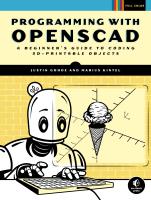Description
OpenSCAD is freely available open source software that enables nondesigners to easily create 3D designs using a text-based programming language. It's a great language for beginners because the instant 3D visualization gives you immediate feedback on the results of your code. This book channels OpenSCAD's visual benefits and user-friendliness into a STEAM-focused, project-based tutorial that teaches the basics of coding, 3D printing, and computational thinking while you develop your spatial reasoning by creating 3D designs with OpenSCAD.
Presuming no prior experience with either programming or 3D design, each chapter builds a scaffolded understanding of core concepts. You'll start by defining, drawing and displaying geometric primitives with text-based code, then expand your creative toolbox with transformation operations - like rotating, reflecting, scaling, and combining shapes.
As the projects become more sophisticated, so will your programming skills; you'll use loops for replicating objects, if statements for differentiating your designs, and parameterized, self-contained modules to divide longer scripts into separate files. Along the way, you'll learn 3D printing tips so that you can produce physical mementos of your progress and get physical feedback that lets you correct mistakes in real time. In addition, the book provides hands-on and accessible design exercises at the end of each chapter so that you can practice applying new concepts immediately after they are introduced.
You'll learn:
Accessibly written for a wide audience (advanced middle schoolers, high school students, college students, artists, makers and lifelong-learners alike), this is the perfect guide to becoming proficient at programming in general and 3D modeling in particular.
Product Details
- No Starch Press Brand
- Aug 26, 2021 Pub Date:
- 9781593279547 ISBN-13:
- 159327954X ISBN-10:
- 206 Pages
- English Language
- 9.25 in * 7 in Dimensions:
- 1 lb Weight:




